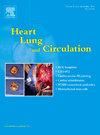体型和肥胖对心血管血流动力学和心肌力学的影响。
IF 2.2
4区 医学
Q2 CARDIAC & CARDIOVASCULAR SYSTEMS
引用次数: 0
摘要
背景:为了改善心血管-肾-代谢综合征的管理,考虑到全球肥胖的日益流行,更好地了解体型对心脏的早期影响是至关重要的,目前仍在研究中。大多数可用的心血管血流动力学数据来自超声心动图,尽管已知在超重和肥胖的背景下图像采集方面存在挑战。通过心脏磁共振成像,我们旨在进一步研究体型对心输出量(CO)和其他心血管疾病早期成像生物标志物的影响。方法:从两项已完成的研究中招募参与者,包括健康志愿者和计划接受减肥手术的肥胖个体。参与者接受了心脏磁共振成像。收集心血管血流动力学和心肌力学指标,包括CO、卒中量、心率、心室容积和心肌应变。评估了这些变量与体型的关系。结果:共招募了57名参与者(79%为女性,平均年龄41岁)。我们观察到CO与身体质量指数(BMI)之间存在正线性关系(p结论:肥胖与CO增加有关;这种增加是心脏重构和随之增加的脑卒中容量的结果。肥胖与使用多室菌株测量的心血管疾病亚临床标志物的损害有关。本文章由计算机程序翻译,如有差异,请以英文原文为准。
The Effect of Body Size and Obesity on Cardiovascular Haemodynamics and Myocardial Mechanics
Background
To improve management of cardiovascular-kidney-metabolic syndrome, a better understanding of the early effects of body size on the heart is crucial and remains under investigation, considering the increasing global prevalence of obesity. Most data available on cardiovascular haemodynamics come from echocardiography despite the known challenges in image acquisition in the context of overweight and obesity. Using cardiac magnetic resonance imaging, we aimed to further investigate the effect of body size on cardiac output (CO) and other early imaging biomarkers of cardiovascular disease.
Method
Participants including healthy volunteers and individuals with obesity who were planning to undergo bariatric surgery were recruited from two completed studies. The participants underwent cardiac magnetic resonance imaging. Measures of cardiovascular haemodynamics and myocardial mechanics were collected, including CO, stroke volume, heart rate, chamber volumes, and myocardial strain. The relationship of these variables with body size were assessed.
Results
A total of 57 participants were recruited (79% female; mean age, 41 years). A positive linear relationship was observed between CO vs body mass index (BMI) (p<0.01) and body surface area (BSA) (p<0.01). A similar trend was seen with stroke volume vs BSA (p<0.01) and BMI (p<0.01). Indexation to BSA rendered chamber volumes similar. We found significant differences in left and right atrial strain between the groups. Regression analysis demonstrated an association between left ventricular global longitudinal strain and right atrial strain with BSA and between left ventricular global longitudinal strain, right ventricular free wall strain, and right atrial strain with BMI.
Conclusions
Obesity is associated with increased CO; this increase is a result of cardiac remodelling and consequent increase in stroke volume. Obesity is associated with an impairment of subclinical markers of cardiovascular disease measured using multichamber strain.
求助全文
通过发布文献求助,成功后即可免费获取论文全文。
去求助
来源期刊

Heart, Lung and Circulation
CARDIAC & CARDIOVASCULAR SYSTEMS-
CiteScore
4.50
自引率
3.80%
发文量
912
审稿时长
11.9 weeks
期刊介绍:
Heart, Lung and Circulation publishes articles integrating clinical and research activities in the fields of basic cardiovascular science, clinical cardiology and cardiac surgery, with a focus on emerging issues in cardiovascular disease. The journal promotes multidisciplinary dialogue between cardiologists, cardiothoracic surgeons, cardio-pulmonary physicians and cardiovascular scientists.
 求助内容:
求助内容: 应助结果提醒方式:
应助结果提醒方式:


